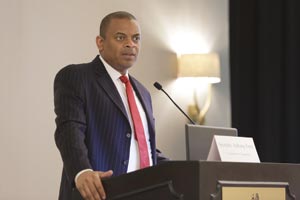DOT’s Foxx Touts White House Push to Expedite Infrastructure Projects

WASHINGTON — Transportation Secretary Anthony Foxx touted the Obama administration’s effort to streamline infrastructure projects through certain improvements to the Federal Infrastructure Permitting Dashboard.
The dashboard tracks agency progress on completing federal permitting and environmental review processes for proposed infrastructure projects.
“To deliver infrastructure projects that achieve real impact for the American people, we need to act with urgency and recognize that every day counts,” Foxx said Sept. 22.
“Today’s actions help us get there. We are pushing ourselves to improve efficiency, coordination and collaboration so that federal permitting becomes a sprint rather than a relay race,” he told a conference hosted by the Long-term Infrastructure Investors Association here.
The administration is acting to expedite the permitting and review process for major infrastructure projects, the director of the Office of Management and Budget said Sept. 22.
OMB and the White House Council on Environmental Quality “issued new guidance providing direction to federal agencies to take a series of actions to significantly expand the use of, and ultimately the number of infrastructure projects on, the Federal Infrastructure Permitting Dashboard,” according to a blog post by OMB’s Shaun Donovan and Christy Goldfuss, the head of White House CEQ.
The change mainly affects DOT, the Army Corps of Engineers and the Coast Guard. The agencies contributed to an update in the “Synchronizing Environmental Reviews for Transportation and Other Infrastructure Projects” handbook, also known as the Red Book. (A posting on the DOT site said it was the first Red Book update in nearly 30 years.)
The Red Book is designed to provide “practical, real-world guidance to federal agencies, applicants, project sponsors and consultants on how to improve the efficiency and effectiveness of key permits and reviews required for these projects,” DOT said.
The Permitting Dashboard was launched in 2012 to highlight and track 52 high-priority projects, such as the Tappan Zee Bridge, as they progressed through the required permitting and review process, DOT said. The guidance also designates specific permitting and review schedules and milestones for each project to report. Additionally, the website for the dashboard recently has been redesigned to accommodate this expansion, and features and functionality will continue to be added, DOT said.
Under the new guidance, the 11 federal agencies that play a significant role in the permitting, review, funding and development of infrastructure projects will, starting in October, identify new infrastructure projects for which standardized milestones and coordinated schedules will be posted within 90 days. Such projects would include major transit projects, airport capital improvements, ports and dams, electricity and broadband transmission, and renewable energy-generation facilities, DOT said.
The reported milestones will include target and actual dates of the receipt of an application, permit issuances or approvals, the release of draft and final environmental impact statements for review and comment, and the issuance of final decisions for all required federal reviews, DOT said.
At the Long-term Infrastructure Investors conference, Foxx said investment agreements on infrastructure projects between government agencies and private investors, while essential, are part of a broader financial strategy to pay for such projects around the country.
“I don’t believe public-private partnerships are the 100% solution to America’s infrastructure deficit. It’s a part of an ecosystem that supports the growth of American infrastructure in more ways,” Foxx told the group.
Public-private partnerships, user fees and billing motorists for the miles they travel are among the tools state and local officials may adopt to back large-scale highway projects.
The association was convening its second annual meeting to introduce investors to national projects. “If you put the 100 key decision-makers in a room, substantial progress in narrowing the gap of mutual alignment can be made,” group Chairman Thierry Deau said.

